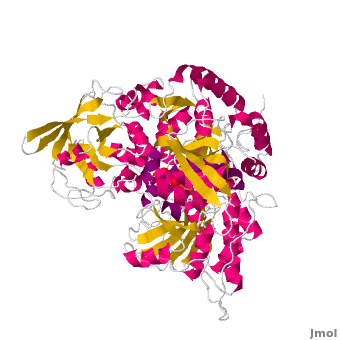Aconitase
From Proteopedia
(Difference between revisions)
(stop spinning the morph) |
(catalytic applet, two scenes) |
||
| Line 1: | Line 1: | ||
'''Aconitase (ACO)''' is an enzymatic domain that confers the ability to catalyse the equilibrium | '''Aconitase (ACO)''' is an enzymatic domain that confers the ability to catalyse the equilibrium | ||
| - | :citrate = aconitate + H<sub>2</sub>O = isocitrate | + | :citrate = aconitate + H<sub>2</sub>O = L-isocitrate |
This reaction is part of the citrate (TCA-, Krebs-)cycle. | This reaction is part of the citrate (TCA-, Krebs-)cycle. | ||
In most organims, there is a cytosolic enzyme with an ACO domain (cAc), and in eukaryotes, a second copy of it was introduced with mitochondria (mAc). Plants developed even more copies in mitochondria. | In most organims, there is a cytosolic enzyme with an ACO domain (cAc), and in eukaryotes, a second copy of it was introduced with mitochondria (mAc). Plants developed even more copies in mitochondria. | ||
| - | <applet load='Morph_2ipy-2b3x.pdb.gz' scene='Aconitase/2ipy-total/2' size='400' frame='true' align='right' caption="" />A specialty of cAc is that in mammals it has developed a <scene name='Aconitase/2ipy-total/2'>second function</scene> as inhibitor of <scene name='Aconitase/2ipy-rna/1'>those mRNA</scene> that carry an <scene name='Aconitase/2ipy-rna-ire/1'>iron- | + | == Catalytic mechanism of mitochondrial ACO == |
| + | <applet load=7acn scene='Aconitase/7acn-sf4/1' size='400' frame='true' align='left' caption="Mitochondrial aconitase from pig, PDB [[7acn]]." />The bulk of citrate cycle processing happens in mitochondria and so, studies concentrated on the mitochondrial ACO. The <scene name='Aconitase/7acn-sf4-3cys/1'>(4Fe-4S) cofactor is held in place</scene> by three sulfur atoms belonging to the cysteins-385, -448, and -451. | ||
| + | |||
| + | <!--It is clear that, in order to synthesize L-isocitrate, stereoselective catalysis must occur.--> | ||
| + | |||
| + | == Cytosolic aconitase and its other function == | ||
| + | <applet load='Morph_2ipy-2b3x.pdb.gz' scene='Aconitase/2ipy-total/2' size='400' frame='true' align='right' caption="Cytosolic aconitase from rabbit (bound to RNA) and human (with Fe4S4 cluster), from PDB [[2ipy]] and [[2b3x]]." />A specialty of cAc is that in mammals it has developed a <scene name='Aconitase/2ipy-total/2'>second function</scene> as inhibitor of <scene name='Aconitase/2ipy-rna/1'>those mRNA</scene> that carry an <scene name='Aconitase/2ipy-rna-ire/1'>iron-responsive element (IRE)</scene>. Therefore, the cytosolic cAc is named IREBP for IRE-binding protein when this function is talked about. Only one of the two functions is active, depending on whether <scene name='Aconitase/2b3x-cluster/1'>the (4Fe-4S) cofactor</scene> is present in the molecule: it's essential for <scene name='Aconitase/2b3x-total/1'>the ACO function</scene>. You can see, by <scene name='Aconitase/Morph/2'>looking at the morph</scene>, how much the enzyme structure differs between those two functions. | ||
<!--== Available structures == | <!--== Available structures == | ||
| Line 26: | Line 32: | ||
*[[2ipy]] - cAc (''Oryctolagus cuniculus'') as IRP1 with ferritin RNA | *[[2ipy]] - cAc (''Oryctolagus cuniculus'') as IRP1 with ferritin RNA | ||
*[[5acn]] - mAc (''Sus scrofa'') with Fe3S4 (missing a Fe) | *[[5acn]] - mAc (''Sus scrofa'') with Fe3S4 (missing a Fe) | ||
| - | *[[6acn]] - mAc (''Sus scrofa'') with | + | *[[6acn]] - mAc (''Sus scrofa'') with tricarballylic acid |
*[[7acn]] - mAc (''Sus scrofa'') with isocitrate | *[[7acn]] - mAc (''Sus scrofa'') with isocitrate | ||
*[[8acn]] - mAc (''Sus scrofa'') with nitroisocitrate | *[[8acn]] - mAc (''Sus scrofa'') with nitroisocitrate | ||
Revision as of 16:34, 18 February 2009
Aconitase (ACO) is an enzymatic domain that confers the ability to catalyse the equilibrium
- citrate = aconitate + H2O = L-isocitrate
This reaction is part of the citrate (TCA-, Krebs-)cycle.
In most organims, there is a cytosolic enzyme with an ACO domain (cAc), and in eukaryotes, a second copy of it was introduced with mitochondria (mAc). Plants developed even more copies in mitochondria.
Catalytic mechanism of mitochondrial ACO
|
Cytosolic aconitase and its other function
Weblinks
Proteopedia Page Contributors and Editors (what is this?)
Michal Harel, Alexander Berchansky, Ralf Stephan, David Canner, Joel L. Sussman, Jaime Prilusky, Anthony Noles, Angel Herraez, Eran Hodis

